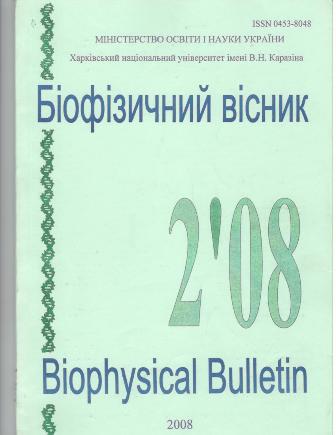Ефективність транспорту енергії в люмінесцентних молекулярних нанокластерів (j-агрегатах)
Анотація
За допомогою екситонної пастки (поліметиновий барвника did) досліджено ефективність екситонного транспорту енергії в люмінесцентних молекулярних нанокластерів (j-агрегатах) поліметиновий барвника amphi-pic. Було показано, що 50% люмінесценції j-агрегатів гаситься при співвідношенні amphi-pic / did = 120, що вказує на ефективний транспорт енергії в даних j-агрегатах в порівнянні з j-агрегатами інших барвників. Було виявлено, що введення поверхнево-активної речовини ЦПБ призводить до підвищення ефективності транспорту енергії за рахунок блокування процесів локалізації екситонів в j-агрегатах. В присутності ЦПБ 50% люмінесценції j-агрегатів гаситься при співвідношенні amphi-pic / did =160.
Завантаження
Посилання
2. Kobayashi T. (Ed.) J-Aggregates. Singapore: World Scientific Publishing. – 1996. – 230 p.
3. Шапиро Б.И. Молекулярные ансамбли полиметиновых красителей // Успехи химии. – 2006. – Т.75,
№5. – С. 484–510.
4. Kirstein S., Dähne S. J-Aggregates of Amphiphilic Cyanine Dyes: Self-Organization of Artificial Light
Harvesting Complexes // Intern. J. Photoenergy. – 2006. – Vol.2006. – article ID 20363, P. 1–21.
5. McDermott G., Prince S.M., Freer A.A. et al. Crystal structure of an integral membrane light-harvesting
complex from photosynthetic bacteria // Nature. – 1995. – Vol.374. – P. 517–521.
6. Malyukin Yu.V., Tovmachenko O.G., Katrich G.S. et al. Exciton Trapping Mechanism in Quasi-ID
Molecular Chains (J-aggregates) // Mol. Cryst. Liq. Cryst. – 1998. – Vol.324. – P. 267–273.
7. Malyukin Yu.V., Sorokin A.V., Lebedenko A.N. et al. Features of exciton transport in J-aggregates of
amphi-PIC // Funct. Mater. – 2005. – Vol.12,№1. – P. 64–68.
8. Tuszyński J.A., Jørgensen M.F., Möbius D. Mechanisms of exciton energy transfer in Scheibe aggregates
// Phys. Rev. E. – 1999. – Vol.59,№4. – P. 4374–4383.
9. Yonezawa Y., Yamaguchi A., Kometani N. Exciton delocalization of the J-aggregate of oxacyanine dye
and thiacyanine dye in LB films // Phys. Stat. Sol. (b). – 2005. – Vol.242,№4. – P. 803–806.
10. Lu L., Helgeson R., Jones R.M. et al. Superquenching in Cyanine Pendant Poly(L-lysine) Dyes:
Dependence on Molecular Weight, Solvent, and Aggregation // J. Am. Chem. Soc. – 2002. – Vol.124,№3.
– P. 483–488.
11. Dai Z., Dähne L., Donath E., Möhwald H. Mimicking Photosynthetic Two-Step Energy Transfer in
Cyanine Triads Assembled into Capsules // Langmuir. – 2002. – Vol.18,№12. – P. 4553–4555.
12. Lang E., Sorokin A., Drechsler M. et al. Optical Spectroscopy on Individual Amphi-PIC J-Aggregates //
Nano Lett. – 2005. – Vol.5,№12. – P. 2635–2640.
13. Malyukin Yu.V., Efimova S.L., Kemnitz K. Spectroscopy of intermolecular interaction in the system:
Dye–sodium dodecyl sulfate micelles // J. Lumin. – 2001. – Vol.94-95. – P. 239–242.
14. Лакович Дж. Основы флуоресцентной спектроскопии. Москва: Мир. – 1986. – 496 с.
15. Malyukin Yu. Coexistence of free and self-trapped excitons in disordered J-aggregates // Phys. Stat. Sol.
(c). – 2006. – Vol.3,№10. – P. 3386–3393.
16. Guralchuk G.Ya., Katrunov I.K., Grynyov R.S. et al. Anomalous Surfactant-Induced Enhancement of
Luminescence Quantum Yield of Cyanine Dye J-Aggregates // J. Phys. Chem. C. – 2008. – Vol.112,№38.
– P. 14762-14768
Автори, які публікуються у цьому журналі, погоджуються з наступними умовами:
- Автори залишають за собою право на авторство своєї роботи та передають журналу право першої публікації цієї роботи на умовах ліцензії Creative Commons Attribution License, котра дозволяє іншим особам вільно розповсюджувати опубліковану роботу з обов'язковим посиланням на авторів оригінальної роботи та першу публікацію роботи у цьому журналі.
- Автори мають право укладати самостійні додаткові угоди щодо неексклюзивного розповсюдження роботи у тому вигляді, в якому вона була опублікована цим журналом (наприклад, розміщувати роботу в електронному сховищі установи або публікувати у складі монографії), за умови збереження посилання на першу публікацію роботи у цьому журналі.
- Політика журналу дозволяє і заохочує розміщення авторами в мережі Інтернет (наприклад, у сховищах установ або на особистих веб-сайтах) рукопису роботи, як до подання цього рукопису до редакції, так і під час його редакційного опрацювання, оскільки це сприяє виникненню продуктивної наукової дискусії та позитивно позначається на оперативності та динаміці цитування опублікованої роботи (див. The Effect of Open Access).





